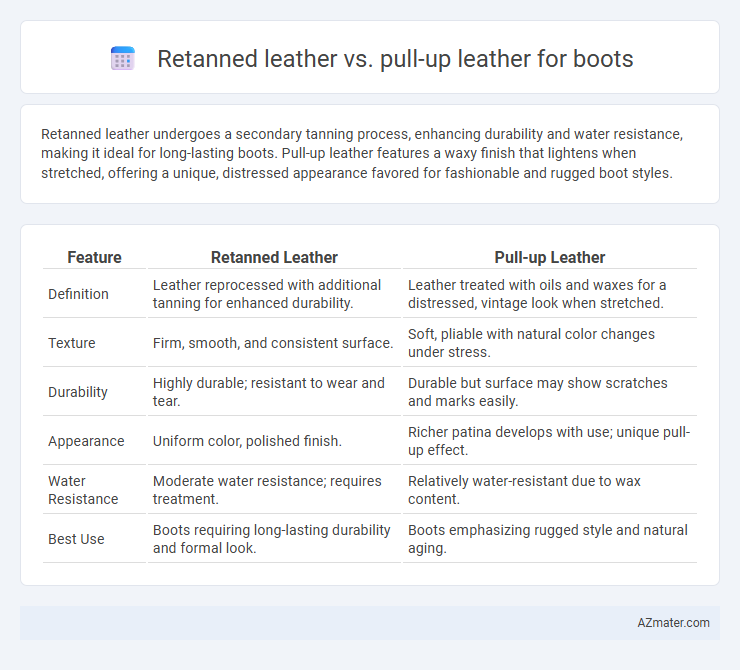Retanned leather undergoes a secondary tanning process, enhancing durability and water resistance, making it ideal for long-lasting boots. Pull-up leather features a waxy finish that lightens when stretched, offering a unique, distressed appearance favored for fashionable and rugged boot styles.
Table of Comparison
| Feature | Retanned Leather | Pull-up Leather |
|---|---|---|
| Definition | Leather reprocessed with additional tanning for enhanced durability. | Leather treated with oils and waxes for a distressed, vintage look when stretched. |
| Texture | Firm, smooth, and consistent surface. | Soft, pliable with natural color changes under stress. |
| Durability | Highly durable; resistant to wear and tear. | Durable but surface may show scratches and marks easily. |
| Appearance | Uniform color, polished finish. | Richer patina develops with use; unique pull-up effect. |
| Water Resistance | Moderate water resistance; requires treatment. | Relatively water-resistant due to wax content. |
| Best Use | Boots requiring long-lasting durability and formal look. | Boots emphasizing rugged style and natural aging. |
Introduction to Retanned and Pull-Up Leather
Retanned leather undergoes a secondary tanning process that enhances durability, making it ideal for sturdy boots designed to withstand harsh conditions. Pull-up leather is characterized by its unique finish that lightens when stretched or bent, offering a distinctive vintage look and a softer, more supple feel. Both materials provide different aesthetic and functional benefits suited for various boot styles and uses.
Understanding Retanned Leather
Retanned leather for boots undergoes a secondary tanning process that enhances durability, suppleness, and resistance to wear, making it ideal for heavy-use footwear. This method often involves natural oils and dyes that penetrate deeply, creating a rich, consistent patina and improved water resistance compared to standard leather. Understanding retanned leather highlights its superior strength and ability to develop character over time, distinguishing it from the more surface-focused pull-up leather.
What is Pull-Up Leather?
Pull-up leather is a type of full-grain leather treated with oils and waxes that create a unique aging effect when stretched or bent, commonly used in high-quality boots for its rugged and vintage appearance. It differs from retanned leather, which undergoes a secondary tanning process using vegetable or synthetic tannins to enhance softness and durability without the characteristic color shift of pull-up leather. Boot manufacturers often select pull-up leather for its distinctive patina that develops over time, highlighting the natural grain and craftsmanship of each pair.
Key Differences Between Retanned and Pull-Up Leather
Retanned leather undergoes a secondary tanning process enhancing durability and flexibility, making it ideal for boots requiring long-lasting wear and resistance to moisture. Pull-up leather is an aniline leather treated with oils and waxes that create a unique distressed appearance as the color lightens when stretched or bent, offering a vintage aesthetic favored in fashion-forward boot designs. Key differences include retanned leather's enhanced structural strength versus pull-up leather's characteristic color variation and soft, supple texture.
Durability Comparison: Retanned vs Pull-Up Leather
Retanned leather offers superior durability due to its additional tanning process, which enhances the hide's strength and resistance to wear, making it ideal for boots subjected to heavy use. Pull-up leather, characterized by its rich, stretchable surface that develops unique patina over time, is durable but more prone to visible scratches and creases compared to retanned leather. For long-lasting boots with high resistance to harsh conditions, retanned leather outperforms pull-up leather in maintaining structural integrity and overall longevity.
Aesthetic Appeal and Aging Characteristics
Retanned leather offers a consistent matte finish that develops subtle patina over time, enhancing the boot's classic and refined aesthetic. Pull-up leather features a distinctive pull-up effect with natural color variations and creases that intensify with wear, providing a rugged, vintage look. Aging characteristics of pull-up leather emphasize dynamic color shifts and pronounced texture changes, while retanned leather matures with more uniform softening and deepening of tone.
Maintenance and Care Requirements
Retanned leather demands regular conditioning with leather oils to maintain its softness and prevent cracking, as it is more processed and less naturally flexible. Pull-up leather requires less frequent conditioning but benefits from occasional cleaning with a damp cloth to preserve its characteristic color shifts and distressed appearance. Both types should be kept away from excessive water and heat to avoid damage, but pull-up leather is generally more forgiving to wear and scuff marks, which enhances its rugged appeal with minimal maintenance.
Water and Stain Resistance Factors
Retanned leather for boots offers enhanced water and stain resistance due to its additional tanning process that increases durability and surface protection. Pull-up leather, treated with oils and waxes, provides a natural water-resistant finish that repels moisture but may require regular maintenance to maintain stain resistance. Both leathers balance protection and aesthetics, but retanned leather generally excels in long-term resistance against water and stains.
Best Use Cases for Boots: Which Leather Wins?
Retanned leather offers enhanced durability and resistance to water, making it ideal for work boots and outdoor activities requiring long-lasting protection. Pull-up leather features a distinctive oily finish that develops a natural patina over time, perfect for fashion-forward boots where style and character are key. For rugged performance and weather resistance, retanned leather wins, while pull-up leather excels in casual and heritage-style boot designs.
Final Verdict: Choosing the Right Leather for Your Boots
Retanned leather offers enhanced durability and a smoother finish, ideal for boots requiring long-lasting wear and refined appearance. Pull-up leather features a natural sheen and unique color shifts under stress, perfect for those seeking a vintage, rugged look with character. Choosing between retanned and pull-up leather depends on whether you prioritize resilience and polish or distinct patina and aesthetic appeal for your boots.

Infographic: Retanned leather vs Pull-up leather for Boot
 azmater.com
azmater.com